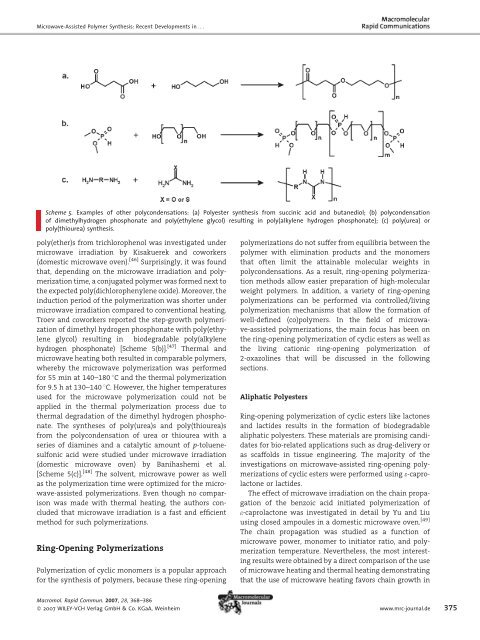Microwave-Assisted Polymer Synthesis: Recent Developments in a ...
Microwave-Assisted Polymer Synthesis: Recent Developments in a ...
Microwave-Assisted Polymer Synthesis: Recent Developments in a ...
You also want an ePaper? Increase the reach of your titles
YUMPU automatically turns print PDFs into web optimized ePapers that Google loves.
<strong>Microwave</strong>-<strong>Assisted</strong> <strong>Polymer</strong> <strong>Synthesis</strong>: <strong>Recent</strong> <strong>Developments</strong> <strong>in</strong> ...<br />
Scheme 5. Examples of other polycondensations: (a) Polyester synthesis from succ<strong>in</strong>ic acid and butanediol; (b) polycondensation<br />
of dimethylhydrogen phosphonate and poly(ethylene glycol) result<strong>in</strong>g <strong>in</strong> poly(alkylene hydrogen phosphonate); (c) poly(urea) or<br />
poly(thiourea) synthesis.<br />
poly(ether)s from trichlorophenol was <strong>in</strong>vestigated under<br />
microwave irradiation by Kisakuerek and coworkers<br />
(domestic microwave oven). [46] Surpris<strong>in</strong>gly, it was found<br />
that, depend<strong>in</strong>g on the microwave irradiation and polymerization<br />
time, a conjugated polymer was formed next to<br />
the expected poly(dichlorophenylene oxide). Moreover, the<br />
<strong>in</strong>duction period of the polymerization was shorter under<br />
microwave irradiation compared to conventional heat<strong>in</strong>g.<br />
Troev and coworkers reported the step-growth polymerization<br />
of dimethyl hydrogen phosphonate with poly(ethylene<br />
glycol) result<strong>in</strong>g <strong>in</strong> biodegradable poly(alkylene<br />
hydrogen phosphonate) [Scheme 5(b)]. [47] Thermal and<br />
microwave heat<strong>in</strong>g both resulted <strong>in</strong> comparable polymers,<br />
whereby the microwave polymerization was performed<br />
for 55 m<strong>in</strong> at 140–180 8C and the thermal polymerization<br />
for 9.5 h at 130–140 8C. However, the higher temperatures<br />
used for the microwave polymerization could not be<br />
applied <strong>in</strong> the thermal polymerization process due to<br />
thermal degradation of the dimethyl hydrogen phosphonate.<br />
The syntheses of poly(urea)s and poly(thiourea)s<br />
from the polycondensation of urea or thiourea with a<br />
series of diam<strong>in</strong>es and a catalytic amount of p-toluenesulfonic<br />
acid were studied under microwave irradiation<br />
(domestic microwave oven) by Banihashemi et al.<br />
[Scheme 5(c)]. [48] The solvent, microwave power as well<br />
as the polymerization time were optimized for the microwave-assisted<br />
polymerizations. Even though no comparison<br />
was made with thermal heat<strong>in</strong>g, the authors concluded<br />
that microwave irradiation is a fast and efficient<br />
method for such polymerizations.<br />
R<strong>in</strong>g-Open<strong>in</strong>g <strong>Polymer</strong>izations<br />
<strong>Polymer</strong>ization of cyclic monomers is a popular approach<br />
for the synthesis of polymers, because these r<strong>in</strong>g-open<strong>in</strong>g<br />
polymerizations do not suffer from equilibria between the<br />
polymer with elim<strong>in</strong>ation products and the monomers<br />
that often limit the atta<strong>in</strong>able molecular weights <strong>in</strong><br />
polycondensations. As a result, r<strong>in</strong>g-open<strong>in</strong>g polymerization<br />
methods allow easier preparation of high-molecular<br />
weight polymers. In addition, a variety of r<strong>in</strong>g-open<strong>in</strong>g<br />
polymerizations can be performed via controlled/liv<strong>in</strong>g<br />
polymerization mechanisms that allow the formation of<br />
well-def<strong>in</strong>ed (co)polymers. In the field of microwave-assisted<br />
polymerizations, the ma<strong>in</strong> focus has been on<br />
the r<strong>in</strong>g-open<strong>in</strong>g polymerization of cyclic esters as well as<br />
the liv<strong>in</strong>g cationic r<strong>in</strong>g-open<strong>in</strong>g polymerization of<br />
2-oxazol<strong>in</strong>es that will be discussed <strong>in</strong> the follow<strong>in</strong>g<br />
sections.<br />
Aliphatic Polyesters<br />
R<strong>in</strong>g-open<strong>in</strong>g polymerization of cyclic esters like lactones<br />
and lactides results <strong>in</strong> the formation of biodegradable<br />
aliphatic polyesters. These materials are promis<strong>in</strong>g candidates<br />
for bio-related applications such as drug-delivery or<br />
as scaffolds <strong>in</strong> tissue eng<strong>in</strong>eer<strong>in</strong>g. The majority of the<br />
<strong>in</strong>vestigations on microwave-assisted r<strong>in</strong>g-open<strong>in</strong>g polymerizations<br />
of cyclic esters were performed us<strong>in</strong>g e-caprolactone<br />
or lactides.<br />
The effect of microwave irradiation on the cha<strong>in</strong> propagation<br />
of the benzoic acid <strong>in</strong>itiated polymerization of<br />
e-caprolactone was <strong>in</strong>vestigated <strong>in</strong> detail by Yu and Liu<br />
us<strong>in</strong>g closed ampoules <strong>in</strong> a domestic microwave oven. [49]<br />
The cha<strong>in</strong> propagation was studied as a function of<br />
microwave power, monomer to <strong>in</strong>itiator ratio, and polymerization<br />
temperature. Nevertheless, the most <strong>in</strong>terest<strong>in</strong>g<br />
results were obta<strong>in</strong>ed by a direct comparison of the use<br />
of microwave heat<strong>in</strong>g and thermal heat<strong>in</strong>g demonstrat<strong>in</strong>g<br />
that the use of microwave heat<strong>in</strong>g favors cha<strong>in</strong> growth <strong>in</strong><br />
Macromol. Rapid Commun. 2007, 28, 368–386<br />
ß 2007 WILEY-VCH Verlag GmbH & Co. KGaA, We<strong>in</strong>heim www.mrc-journal.de 375
















